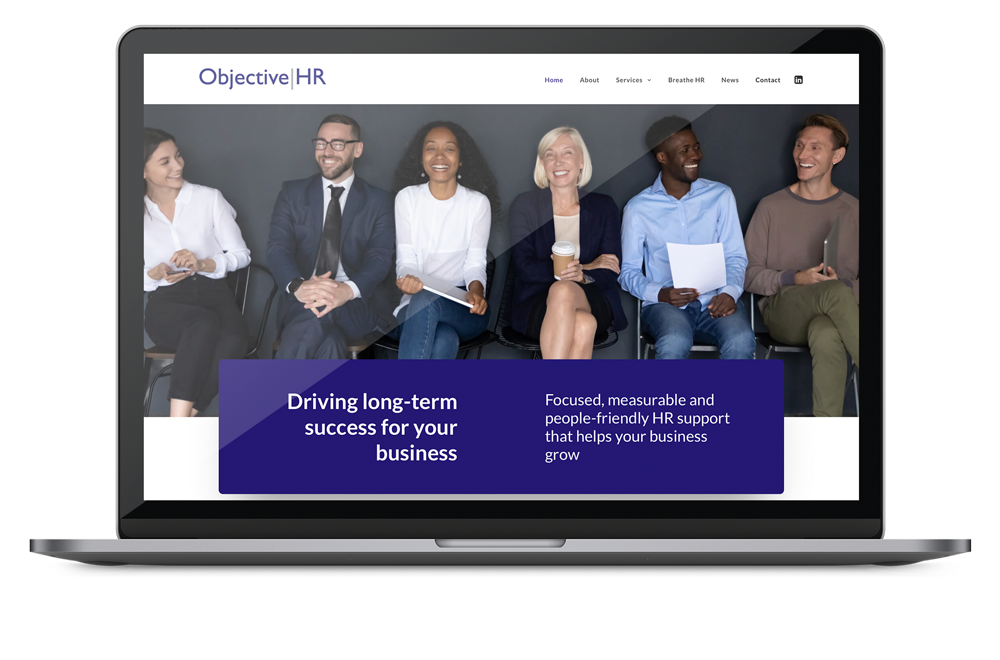Our new website is live!
We’re very proud to see our new website go live today. It’s been a few months in the making, and it showcases all the services we offer to clients, including:
- HR consultancy services
- Screening and referencing
- Recruitment
- Learning and development
We’ve added some great resources, and our most recent blogs are there too. We’ll be adding regular content to help employers, employees, candidates, recruitment managers and HR professionals to keep up-to-date and make sure they are following the latest best practice.
“We wanted to have a much newer and clearer site that outlines the four pillars of our business and to share some of the template information with clients and visitors,” says MD Lisa Collins. “Our business has established a reputation for professionalism and excellence and we needed to update our website to reflect that. We’re really looking forward to continuing to help our customers with all their HR needs, and to meeting new clients who will benefit from our range of services.”

A guide to making your business Covid secure
There’s been a lot of talk recently about returning to office-based workplaces – the government has advised that employees can still work from home if they are able, but can return as long as workplaces are Covid-safe.
But what does ‘Covid-safe’ mean to your business? It’s about more than ensuring safe distancing and clean environments. Employers will need to make sure that their admin and HR policies are up-to-date and reflect the new working conditions we find ourselves in.
The government has produced a range of guidance for employers, and this guidance is frequently updated, so we are recommending that our clients check the government website regularly to ensure they are taking the latest advice. You can find the current guidance here: https://www.gov.uk/guidance/working-safely-during-coronavirus-covid-19
We’ve highlighted the guidance that we think is most valuable for employers at the moment:
A risk assessment – employers should conduct a full risk assessment of the workplace. This includes office spaces and call centres, and if your business also operates a production area, delivery vehicles or retail premises, a separate risk assessment should be conducted for each area. Self-employed people and businesses with fewer than five employees don’t need a written risk assessment, but businesses larger than that will need to have a written assessment available.
HR records – make sure that your records are completely up-to-date. This will be essential if you need to manage a track-and-trace operation. You should also be having conversations with each employee about how they feel about returning to work, and what particular circumstances they are dealing with, including childcare and vulnerable care responsibilities. This should be noted on each file so that there is a formal record of the conversations you have had.
Draft a Covid response plan – earlier in the year, businesses had to plan on the go, but now that we are much more aware of what may happen, it’s worth having a plan that sets out how you might deal with a future wave of the virus. This might reflect some of the decisions you took during the first wave, and it should be communicated with and available to your employees. You may also find that job applicants now ask to see a copy of your Covid plan.
Communication – good, clear and transparent communication with your employees is a key part of getting back to work and managing any future issues. Keeping communication lines open, and updating your employees as things change will help them to feel consulted and connected, and therefore more supportive to your plans as people start to return to the office over the next few months.
Recruiting? You might get more than you bargained for
Recent months have seen thousands of people being made redundant. Despite all the schemes put in place to help businesses and individuals, some companies simply haven’t been able to maintain operation at the same level as the start of the year, and that means there are a lot of people chasing the available jobs.
This point was made fairly starkly recently when a hotel reported that it had received more than 1,000 applications for a receptionist role. It had only expected 30. Dealing with the volume of applications is one thing: weeding out the people who actually have the skills or experience to do the job is quite another.
A recent survey by the Recruitment and Employment Confederation found that those employers who are looking for new staff are becoming more confident about starting to hire as their businesses start to return to work after the lockdown. Of course, some businesses have been extremely busy and needed to hire during lockdown, whilst others have been biding their time and waiting to see what a post-lockdown business world looks like. But the fact that businesses are now actively hiring at the same time as growing numbers of people are looking for work means that employers could suddenly see a significant rise in applications.
How to manage job applications
The easiest way to reduce the burden of sifting through hundreds of applications is to work with a recruitment partner. That way, you’ll still see just the most relevant and useful CVs to help you take the next step. It may take longer to get to this point, however, because each application will need to be read and considered.
You could also be clear in your job adverts about exactly what you’re looking for. This may deter people who are applying for ‘anything’ and leave the path clear for the applicants who have the skills or experience you need. This isn’t guaranteed, however: we have been working on recruitment for some very specific roles, only to find that we are getting hundreds of applicants, many of whom have none of the skills or qualifications needed.
Instead, employers may have to accept that, for the moment at least, you will be over-subscribed if you advertise a new post. At the same time, you need to have a policy for how you manage rejections, because poor management could reflect badly on your brand reputation for years to come. More importantly, we’re hearing that people are struggling with low self-esteem around rejection on top of poor mental health because of the challenges of the pandemic, so it remains the employer’s role to handle applications responsibly and with empathy wherever possible
Will you be claiming the job retention bonus?
At the beginning of July, the Chancellor announced a scheme known as the Job Retention Bonus, to help employers across the country save jobs wherever possible.
The bonus relates to employees who have been furloughed, and who might otherwise be made redundant rather than being brought back into the business. If the employer brings those people back and employs them between November and January – November being the month after the furlough scheme ends – the government will pay the business a bonus of £1,000 for each worker.
In order to qualify for this bonus, the employee must earn at least the lower earnings limit for national insurance – currently £520 per month – during the entire period. The scheme is designed to help employers retain staff who would otherwise be at risk of redundancy.
Worries about bonus abuse
The announcement, which the Chancellor said could amount to a £9bn support package if the bonus was claimed for all furloughed workers, has led to some concern that employers may claim the bonus even for staff whose jobs are not at all at risk.
In fact, a range of national brands have already said that they wouldn’t be claiming the bonus, and developer Barrett Homes said that not only would they not claim the bonus, they would also pay back the furlough money claimed from the during lockdown.
Will you claim?
If your business has been considering redundancies because of the financial impact of lockdown – or because you have discovered that you may be able to run your business more efficiently with fewer people – this might help you to keep those jobs secure for a little longer. This gives you the chance to get back to business, improve your cash flow and perhaps keep some of those jobs in the long term.
Conditions for the scheme
- Your employee must have been furloughed on the existing Job Retention Scheme and HMRC must have made a payment to you in respect of that employee.
- The employee must return to work from furlough in November and be continuously employed until January 31st 2021 at the earliest. Those workers who have already returned from furlough may also qualify the employer to claim on the bonus scheme.
- The employee must earn an average of more than £520 per month before tax during this period.
Advisers and business experts have expressed hope that the process of applying and receiving the claims is not too bureaucratic, so that businesses who have taken employees back can be sure of getting the bonus promptly in February 2021, when it is due to be paid.
Have you been considering redundancy for some of your employers? Has this news changed your plans? If you are still contemplating redundancies, you'll need to make sure you follow the correct processes, including fair selection - for help and support, contact us today.
Have you been affected by CV fraud?
As we move into a position where a large number of people are going to be job-hunting and some employers need to take on increasing numbers of staff, it’s important to make sure that your business is not losing money because of fraudulent candidates.
Research has showed that around 20% of CVs have some sort of misdirection on them, and feedback from employers has highlighted that nearly 50% have experienced candidates who lied about their degree qualifications.
CV and job application fraud has a knock-on effect on your business and finances. If someone is prepared to lie on their CV, they are less likely to be trustworthy employees. And if they have lied about their qualifications, they may not have the essential knowledge, skills and capability that you require for the position.
Fraud in the digital age
Whilst it’s true that it’s harder to commit CV or job application fraud now that so much information is available online for third party sources, it doesn’t seem to have prevented some candidates from trying to get one over on employers.
This type of fraud is often discovered too late: the employee has been hired, paid and invested in. In order to correct the problem you’ll have to spend time and money on dismissing the original employee and starting your recruitment all over again.
- That’s why it’s so important to have a rigorous screening and referencing programme as part of your recruitment process. And it’s not just about having the process in place; it’s about making it clear to candidates that you will be checking their details for accuracy and honesty. This helps your business in a number of ways:
Discourages fraudulent candidates from applying for your jobs - Enhances your reputation as an employer that values honesty and transparency
- Gives you confidence that you are spending your recruitment budget efficiently and wisely
- Builds a strong relationship between you and your candidates/new hires
- Allows you to concentrate on growing your business successfully
What does screening and referencing offer?
Screening and referencing allows you to make sure that your candidates are who they say they are. It also gives you the opportunity to ensure your candidates have the right to work in the UK – which will become particularly important on January 1st 2021, when new immigration procedures come into force – and it means you can check qualifications, experience and professional memberships.
Screening as part of your recruitment process helps to give your candidates confidence in your process and gives your business confidence in the candidates, and it should be built into your recruitment process as a matter of course.
Does home-working affect teamwork and socialisation?
We’ve been thrust into a situation where homeworking has become the norm for many. But is it the best option for everyone? Not necessarily. There are lots of reasons why homeworking is good; studies show that some people are more productive when working from home, for example. But equally, not everyone has enough space to work well from home; not everyone has a good-enough broadband connection; not everyone wants to stay at home all the time.
So how are businesses going to approach the issue of homeworking now? Here are some of the pros and cons that we’ve discovered through working with our clients during this period:
• Productivity – for many, homeworking has resulted in greater productivity. The lack of a morning and evening commute means that people can get straight to their desks, and often take less time for lunch and are less distracted during the day.
• Caring responsibilities – homeworking can be useful for those with caring responsibilities – either for children, parents or other relatives. Being in the home means they can manage any visits or appointments needed and can adjust their working hours if possible, to accommodate school runs. Studies have shown that people who work at home for this reason are often very productive because they are aware of the flexibility they enjoy from their employer. However, this is a balance: managers and business owners will want to make sure that the employer is able to perform all their tasks from home and won’t be disturbed or distracted by their other responsibilities.
• Teamwork – teams often work best when they are in the same place, so homeworking could have a negative effect on the way that teams work together. Keeping a remote team working closely together requires more planning, more effort and more measurement, so businesses offering this opportunity will need to make sure they are providing the support needed to keep teams together.
• New hires – working in the office is a positive part of the induction process for new hires. It gives them a chance to integrate into the business, to get to know the people they are working with and to have a sense of purpose from day one. Starting a new job remotely – as many people have discovered during the pandemic – is a strange and difficult way to begin a new job and, like managing teams, requires more effort from line managers to ensure that new hires are able to work well.
• Managing absence – it’s easier for work to be picked up by others when everyone is in the office. Handing over tasks or projects ahead of holidays, during a period of long-term absence or even just for a week’s sickness is much easier when everyone is in the same place. Managing work handovers remotely is more time-consuming and requires advance organisation.
In the end, of course, this is going to be a choice for each business, based on the type of business and the job role. But it’s more than likely that many employees will be asking either for full-time homeworking or a split between office and home and businesses need to have a plan in place to deal with this new way of doing things.
5 ways to manage returning employees
As lockdown eases and businesses of all types can return to work, employees need to be treated fairly and with respect.
Some employees may be anxious about returning to work at all; others may want to renegotiate working conditions so that they can work more often from home. Employees who have been shielding since March will be able to go back to work from August, and will need significant support in order to do so.
So, what must you do to manage these issues to make sure that your employees are taken care of and their concerns heard, whilst also making sure that your business can continue to run smoothly?
1. Understand individual positions
It’s important that employers listen to the individual concerns of employees. In smaller businesses, line managers, HR managers and even Managing Directors can have individual conversations with employees to find out how they feel about returning. In larger businesses, every employee should have the opportunity to express any concerns they have about returning to work.
2. Vary work patterns for furloughed workers
The changes in the government’s furlough scheme come into force in July. From then, employers can bring furloughed workers back into the business for any amount of time, whilst still claiming furlough payments for time not worked. Just as employees needed to agree to be put on furlough in the first place, they will need to agree the way in which they come back, particularly if they have anxieties as carers for vulnerable people.
3. Consider parental and carer responsibilities
With schools unlikely to return to full opening until September, those caring for children may need to be more flexible in their working patterns. Employers need to think about the circumstances of these employees and be as flexible as possible with encouraging return to work, varying contracts if necessary to protect the jobs of employees who need to continue flexible or home working in order to manage childcare.
4. Communicate clearly and often
One of the most common complaints from employees at times of change is the lack of communication. It’s extremely important to keep employees in the loop about your progress both in terms of returning to work and in terms of risk assessments and health and safety. Encouraging employees to ask questions and make suggestions about how they can work safely and productively will engage them in the process of returning to work and give them the information they need to make the right decisions about their own return.
5. Embrace new ways of working
Many employers have discovered that businesses can operate even when the office is shut. You may have discovered ways to streamline your processes or to save money on your office rental. The fact that everyone is now used to holding virtual meetings means that daily face-to-face working may not be as vital as before, and you now have the opportunity to improve productivity. Whilst for some businesses this may mean an eventual reduction in the workforce, for many employers, this presents an opportunity to save money, do things better and offer more flexibility to employees.
Finally, remember that the negotiations and contract variations you make may only be temporary, so you’ll need to set review dates with each individual and keep track of how the new arrangements are working.
For help and advice with helping your employees return to work, just contact us today.
How are you managing employee holidays?
It might seem like a ridiculous question, given that we can’t travel or stay in other houses, but a holiday’s about more than ‘getting away’, and you should be aware of how you might manage employee holiday requests now and in the future.
This period has been hard work for everyone. Whatever you’ve been doing: on furlough, working normally, working longer hours, shielding, caring for a vulnerable family member or facing the possibility of making staff redundant – it’s been a trying and worrying few months.
And, although things are slowly starting to return to business, you and your employees will still need a break. Whilst there’s a limit to where you can travel, you can get to see friends and family, you can celebrate special events and you can take some time to relax and switch off.
Managing excess holiday
Employees can now carry leave over for the next two leave years, to take into account the fact that businesses are having to work differently to manage the impact of COVID-19.
Guidance on the government’s website states:
“Currently, almost all workers are entitled to 28 days’ holiday including bank holidays each year. However, most of this entitlement cannot be carried between leave years, meaning workers lose their holiday if they do not take it.
There is also an obligation on employers to ensure their workers take their statutory entitlement in any one year – failure to do so could result in a financial penalty.
The regulations will allow up to 4 weeks of unused leave to be carried into the next 2 leave years, easing the requirements on business to ensure that workers take statutory amount of annual leave in any one year.”
So employers will need to manage the carrying-over of leave whilst also making sure that employees take leave in a way that is sustainable for the business, and promotes their wellbeing.
How to talk to your people about holiday
Holiday is one of the most precious benefits that a company offers. Many companies offer more than the standard holiday entitlement, including things like a holiday on an employee’s birthday and holiday rewards as part of recognition schemes. There are also holiday buy-back schemes and all these variations will need to be taken into account.
If you have employees that want to take holiday at this point, accommodate them if you possibly can. It could be that they have had a stressful time and need to recuperate – or that they have had COVID-19 and want to make the most of recovery. Or it could be that the holiday time was booked in advance and they still want to take it, even if holiday plans have been cancelled.
Whilst you need to make sure that you have the staff and skills to help your business return to work or meet new demand, you have to balance this with the impact on your employees’ wellbeing from not taking a holiday until much later in the year.
What to think about if you’re an employee returning to work
Now that more businesses are planning to re-open, employees are starting to think about heading back to work.
For some, it’s an easy decision – as long as the workplace is safe and well-managed, it might be a relief to get out of the house and back into a routine.
For others, however, this is a stressful time, and it’s important that as well as looking after your finances and organising your household around a return to work, you also look after your own wellbeing. So ask yourself these simple questions:
How will I get to work?
If you normally travel to work by public transport, are you currently happy to travel that way? Have you checked that the routes you use are running as usual? Might you have to leave home earlier or later than usual in order to get to work safely? Are there any alternatives available to you, such as walking part or all of the way, cycling, or driving? If you can’t get to work any other way and you’re worried about using public transport, can you talk to your employer?
Can I still work from home?
At the moment, the Government’s advice is to work from home if you can. So if your job function can be carried out fully at home, you should remain working from home unless your employer specifically asks you to return. In that circumstance, you are entitled to ask to remain working from home, particularly if you are concerned about the health implications of going back.
How will I manage caring responsibilities?
Lots of employees are also caring for children or vulnerable people during this period. At the moment, only a select number of children have returned to school, and vulnerable people are still being asked to be cautious about going out. So you may be worried about a conflict between what your employer expects you to do and what you are able or comfortable to do. If this is the case, speak to your employer as soon as possible. Explain your situation and see if you can work together to come to a solution that works for everyone.
What if I’m just scared about returning to work?
This period of virus crisis and lockdown has had a significant effect on the way people view their personal safety. Some are not yet ready to spend lots of time with other people, or venture too far away from home. Again, if you are worried about getting back to work and the effect it might have on you and your family, talk to your employer to see if anything can be arranged to help.
Employers are required to help you return to work confidently and safely, and most are making incredible efforts to change working environments and processes so that everyone feels safe as and when they return to work. It’s always best to talk to your employer in advance so that they are aware of any potential issues, and to keep a note of when you spoke and what was said so that you have clear information to refer to should you need to.
Why not consider a phased return to work? This will help you to make the transition from being at home – whether furloughed or working remotely – back into your usual environment. We are working with a number of clients now who are introducing phased returns to support their employees and this is a great way to manage a safe return to work.
CEOs and MDs need to be kinder to themselves
There’s been no shortage of articles online and in the press about ‘how to be a better leader’ during the COVID-19 crisis. Of course, leaders are having to do things differently and think about their business and their employees in a different way, but being inundated with articles and thought pieces telling you just how badly you could be doing doesn’t help.
In fact, our experience is that leaders are working harder than ever, whilst also making sure that their employees are taking time out, flexing work around caring responsibilities and looking after their mental and physical wellbeing.
Anecdotally, we’re hearing that bosses are working longer hours from home and keeping devices on so that they can respond to business and employee concerns at any time. They’re trying to keep track of the support on offer and preparing for a return to work, all whilst keeping the business operational in difficult times.
If you’re a leader whose business is still operating during this period, you’re likely to be busier than ever. You may have to re-structure your business completely – something that you usually have the luxury of doing over a significant period of time. Or you may have to change your operations to account for the restrictions in opening or social distancing. You may have re-focused your business into designing, developing or producing equipment and supplies to help support the health service, or you might have re-directed your drivers to help charities with food deliveries.
You may just be one of the fortunate businesses who have seen demand for certain products rise and are trying to meet that demand safely and with a sympathetic customer service experience.
Whatever the circumstances, it seems that leaders aren’t practicing what they preach to their staff. This means that when you do return to work you could be tired, mentally low and not really able to motivate and support your staff in what will be a tricky transition.
So, if you’ve been working 12-14 hour days for the past three months, from an office that you’ve put together at home, being in contact 24/7 and not taking any extra time off, perhaps now is the time to re-assess the way you work.
Take some days off. Put some boundaries around your working hours. Shut your office down in the evening and either put your laptop away or shut the door to the room it’s in so that you’re not tempted to check emails. Set specific times when you’ll be available for calls and stick to them.
Your people will respect that you’re taking some time for yourself – and taking the advice that you’re giving to them. And you’ll be in a better physical and mental place to take on the next challenge.








